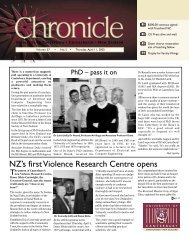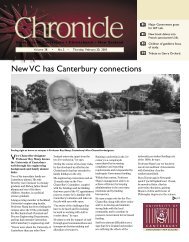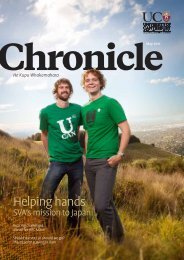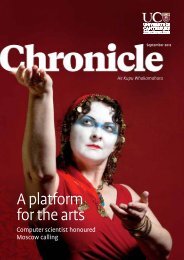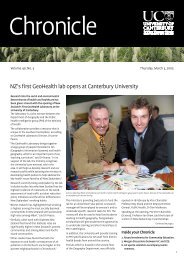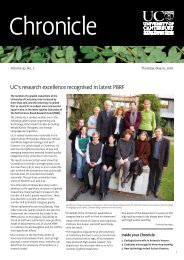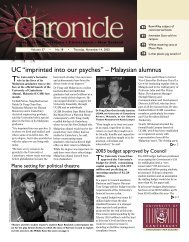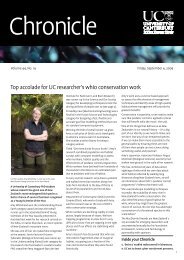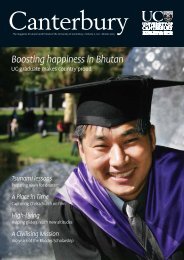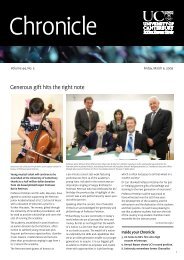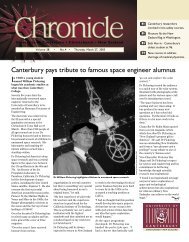Download - Communications and Development Department ...
Download - Communications and Development Department ...
Download - Communications and Development Department ...
Create successful ePaper yourself
Turn your PDF publications into a flip-book with our unique Google optimized e-Paper software.
Life through T-ray spectaclesBy David HaywoodDr Tim DrysdaleTeraView’s terahertz imaging system shows the fullextent of a skin cancer (depicted in red).Microscale detail of the structure of the terahertz filter.QinetiQ’s terahertz (millimetre-wave) imaging systemreveals hidden weapons.Image courtesy of QinetiQ. Image courtesy of University of Glasgow.Image courtesy of TeraView.Photo courtesy of Tim Drysdale.“Amazing X-ray Spectacles” have beenadvertised in the back pages of Americancomic magazines for more than 50 years.The spectacles have swindled generationsof misguided schoolboys with theirclaim that the wearer will “see throughclothes!”. The would-be voyeur learnsan important lesson about advertisingwhen a pair of opaque cardboard glasses(labelled “novelty value only”) eventuallyarrives in their letterbox.However, real-life systems that cansee through clothing have now beendeveloped. “Although they are a lot largerthan a pair of glasses,” says Universityof Canterbury graduate Dr Tim Drysdale.These machines produce an image using“T-rays” or terahertz radiation, a formof electromagnetic radiation that canpass straight through clothing but notthrough flesh.Imaging systems using terahertz radiationhave the potential to detect weapons <strong>and</strong>contrab<strong>and</strong> concealed under clothing.These systems offer a significantimprovement on current security <strong>and</strong>anti-terrorism technology, <strong>and</strong> also havea number of possible applications in themedical industry.Drysdale graduated from Canterbury witha BE(Hons) in electrical <strong>and</strong> electronicengineering in 1999 <strong>and</strong> has beenresearching terahertz technology sincestarting his PhD at UC in 1999.“The conventional devices used tomanipulate radio <strong>and</strong> optical wavesgenerally aren’t suitable for use atterahertz frequencies,” explains Drysdale.“So my doctoral work concentrated ondeveloping fundamental componentsthat would allow terahertz radiation to beaccurately controlled.”This research led to a terahertz filterthat can “tune” the radiation frequencyemitted <strong>and</strong> received by terahertzsystems. Drysdale was granted a patentfor his terahertz filter in 2001. His doctoralsupervisor Associate Professor RichardBlaikie <strong>and</strong> long-time collaboratorProfessor David Cumming (University ofGlasgow) were co-inventors on the patent.Safety is an important selling point interahertz technology. Terahertz radiationlies in the far-infrared region — well belowthat of visible light — so its frequencyis orders of magnitude lower th<strong>and</strong>angerous radiation such as X-rays<strong>and</strong> gamma-rays, <strong>and</strong> yet higher thanpotentially harmful microwaves.“The energy in each photon is minimal atterahertz frequencies,” explains Drysdale.“So it’s completely non-ionizing; thephotons just don’t have the energy toknock away electrons. On the other h<strong>and</strong>,the imaging systems operate at suchlow powers that heating effects aren’t aproblem either.”Different substances reflect terahertzradiation in different ways. This enablesterahertz imaging to see tooth decay,<strong>and</strong> means that future dental-scanningtechnology could reduce the exposureof dental staff <strong>and</strong> patients to X-rays.Terahertz devices have also proven to be aninvaluable tool in identifying skin cancers.“Sometimes skin cancers will appearsmall,” says Drysdale, “but the diseasedarea extends into the surroundinghealthy-looking skin. Terahertz imagingcan identify exactly where the cancer islocated, <strong>and</strong> this helps the surgeon toremove all the affected tissue.”After completing his PhD, Drysdale wasrecruited by the prestigious <strong>Department</strong>of Electronics <strong>and</strong> Electrical Engineeringat the University of Glasgow. Hispostdoctoral work has resulted in threefurther patents with Cumming <strong>and</strong> anumber of industrial collaborations.His work was recently selected by theRoyal Society for an exhibition atBuckingham Palace. “Part of the exhibitdemonstrated the potential of terahertzpassenger screening systems by using a‘terrorist’ mannequin that had replicaguns, knives <strong>and</strong> explosives concealedwithin its clothing,” he says.“Using British company QinetiQ’scommercial terahertz (millimetre-wave)imaging technology, you can immediatelysee not only the body beneath the clothesbut any hidden weapons.“Of course, there are obvious privacyissues with such images, but QinetiQhas developed something called ‘fig leaf’technology,” he explains reassuringly. “Thispixellates the groin area for all passengers<strong>and</strong> the chest area for females, so theoperator doesn’t see any more than theywould at the beach. It’s only the computerthat gets the whole picture.”Drysdale recently completed hispostdoctoral research, <strong>and</strong> was appointedto the position of lecturer in theElectronics Design Centre at the Universityof Glasgow.34 Canterbury Magazine



